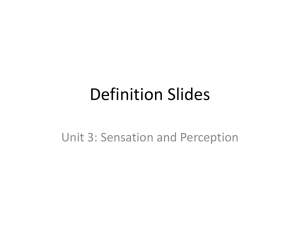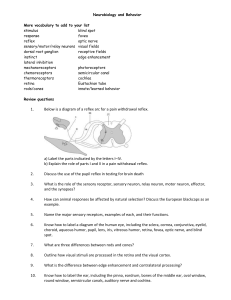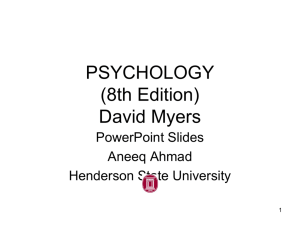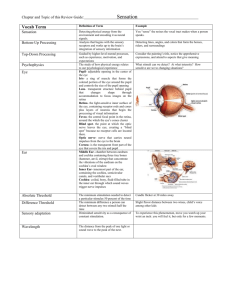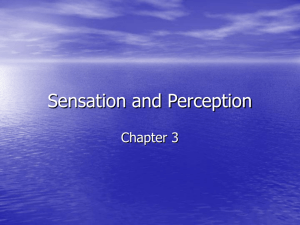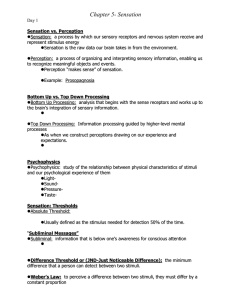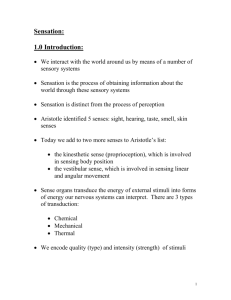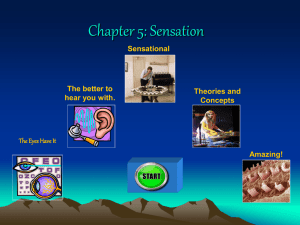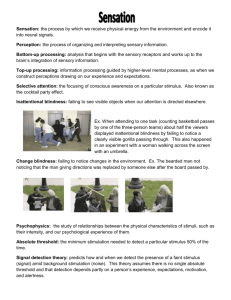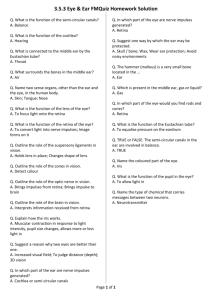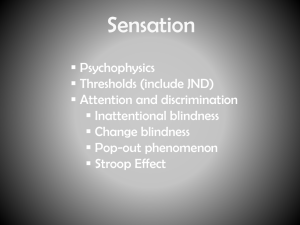Sensation and Perception
advertisement
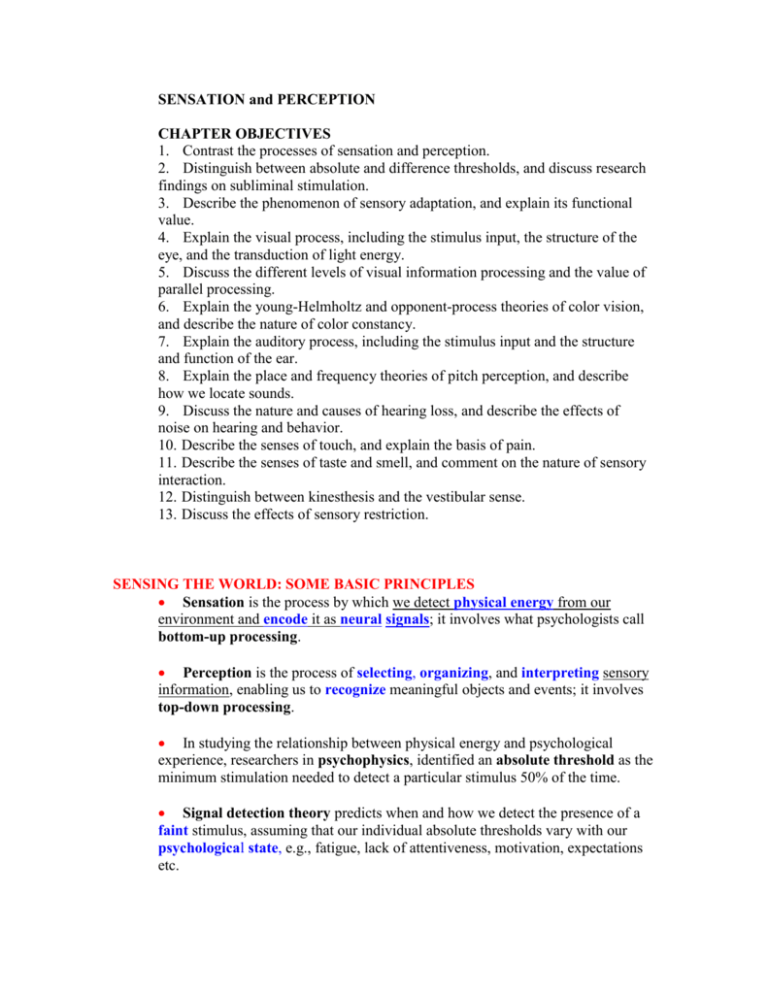
SENSATION and PERCEPTION CHAPTER OBJECTIVES 1. Contrast the processes of sensation and perception. 2. Distinguish between absolute and difference thresholds, and discuss research findings on subliminal stimulation. 3. Describe the phenomenon of sensory adaptation, and explain its functional value. 4. Explain the visual process, including the stimulus input, the structure of the eye, and the transduction of light energy. 5. Discuss the different levels of visual information processing and the value of parallel processing. 6. Explain the young-Helmholtz and opponent-process theories of color vision, and describe the nature of color constancy. 7. Explain the auditory process, including the stimulus input and the structure and function of the ear. 8. Explain the place and frequency theories of pitch perception, and describe how we locate sounds. 9. Discuss the nature and causes of hearing loss, and describe the effects of noise on hearing and behavior. 10. Describe the senses of touch, and explain the basis of pain. 11. Describe the senses of taste and smell, and comment on the nature of sensory interaction. 12. Distinguish between kinesthesis and the vestibular sense. 13. Discuss the effects of sensory restriction. SENSING THE WORLD: SOME BASIC PRINCIPLES Sensation is the process by which we detect physical energy from our environment and encode it as neural signals; it involves what psychologists call bottom-up processing. Perception is the process of selecting, organizing, and interpreting sensory information, enabling us to recognize meaningful objects and events; it involves top-down processing. In studying the relationship between physical energy and psychological experience, researchers in psychophysics, identified an absolute threshold as the minimum stimulation needed to detect a particular stimulus 50% of the time. Signal detection theory predicts when and how we detect the presence of a faint stimulus, assuming that our individual absolute thresholds vary with our psychological state, e.g., fatigue, lack of attentiveness, motivation, expectations etc. Recent research reveals that we can process some information from stimuli too weak to recognize. However the restricted conditions under which this occurs would not enable advertisers to exploit us with subliminal messages. A difference threshold is the minimum difference in stimulation that a person can detect 50 % of the time. In humans, difference thresholds (experienced as a just noticeable difference (jnd)) increase in proportion to the size of the stimulus--- a principle known as Weber’s law. Sensory adaptation refers to the diminished sensitivity that is a consequence of continued stimulation. This enables us to focus our attention on informative changes in our environment without being distracted by the uninformative, constant stimulation of garments, odors, and street noise. VISION The energies we experience as visible light are a thin slice from the broad spectrum of electromagnetic radiation. Our sensory experience of light is determined largely by the light energy’s wavelength, which determines the hue of a color, and its intensity, which influences brightness. After light enters the eye through the pupil, whose size is regulated by the iris, a camera-like lens focuses the rays by changing its curvature, a process called accommodation, on the retina. Acuity, or sharpness of vision, can be affected by small distortions in the shape of the eye. In nearsightedness, nearby objects are seen more clearly than distant objects because the lens focuses the image of distant objects in front of the retina. In farsightedness, faraway objects are seen more clearly than near objects because the image of near objects is focused behind the retina. The retina’s rods and cones (most of which are clustered around the fovea) transduce the light energy into neural signals. These signals activate the neighboring bipolar cells, which in turn activate the neighboring ganglion cells, whose axons converge to form the optic nerve that carries information to the brain. Where the optic nerve leaves the eye there are no receptor cells --creating a blind spot. The cones enable vision of color and fine detail; the rods remain sensitive in dim light. We process information at progressively more abstract levels. The information from the retina’s 130 million rods and cones is received and transmitted by the million or so ganglion cells whose fibers make up the optic nerve. When individual ganglion cells register information in their region of the visual field, they send signals to the visual cortex. In the cortex, individual neurons (feature detectors) respond to specific features of a visual stimulus. The visual cortex passes this information along to the temporal and parietal cortex, which includes higher-level brain cells that respond to specific visual scenes. Other super-cell clusters integrate this information and combine it with our assumptions, interests, and expectations. Sub-dimensions of vision (color, movement, depth, and form) are processed separately and simultaneously, illustrating our brain’s capacity for parallel processing. This contrasts sharply with the step-by-step processing of most computers and of conscious problem solving. Color vision: The Young-Helmholtz trichromatic (three-color) theory states that the retina has three types of color receptors, each especially sensitive to red, green, or blue. When we stimulate combinations of these cones, we see other colors. For example, when both red- and green-sensitive cones are stimulated, we see yellow. Hering’s opponent-process theory states that there are two additional color processes, one responsible for red versus green perception, and one for yellow versus blue. Subsequent research has confirmed that after leaving the receptor cells, visual information is analyzed in terms of the opponent colors red and green, blue and yellow, and black and white. Thus, in the thalamus some neurons are turned “on” by red, but turned “off” by green. Others are turned on by green but off by red. These opponent processes help explain afterimages. Color constancy refers to our perceiving familiar objects as having consistent color, even if changing illumination alters the wavelengths reflected by the object. We see color as a result of our brain’s computations of the light reflected by any object relative to its surroundings. HEARING Audition, or hearing, is highly adaptive. The pressure waves we experience as sound vary in amplitude and frequency and correspondingly in perceived loudness and pitch. Decibels are the measuring unit for sound energy. Through a mechanical chain of events, sound waves traveling through the auditory canal cause minuscule vibrations in the eardrum. Transmitted via the bones of the middle ear ( the hammer, anvil, and stirrup) to the fluid-filled cochlea in the inner ear, these vibrations create movement in tiny hair cells on the basiliar membrane, triggering neural messages to the brain. Pitch perception: Place theory presumes that we hear different pitches because different sound waves trigger activity at different places along the cochlea’s basiliar membrane. Thus, the brain can determine a sound’s pitch by recognizing the place on the membrane from which it receives neural signals. Frequency theory states that the rate of nerve impulses traveling up the auditory nerve matches the frequency of a tone, thus enabling us to sense its pitch. For example, if the sound wave has a frequency of 100 waves per second, then 100 pulses per second travel up the auditory nerve. REMEMBER: Individual neurons cannot fire faster than 1000 times per second. For frequencies above 1000 waves per second, volley principle is handy. Like soldiers who alternate firing so that some can shoot while others reload, a group of neural cells can alternate firing. By firing in rapid succession they can achieve a combined frequency well above 1000 times per second. PLACE THEORY BEST EXPLAINS HOW WE SENSE HIGHPITCHED SOUNDS, AND FREQUENCY THEORY BEST EXPLAINS HOW WE SENSE LOW-PITCHED SOUNDS. We localize sounds by detecting minute differences in the intensity and timing of the sounds received by each ear. Problems with the mechanical system that conducts sound waves to the cochlea cause conduction hearing loss. If the eardrum is punctured or if the tiny bones of the middle ear lose their ability to vibrate, the ear’s ability to conduct vibrations diminishes. A hearing aid may restore hearing by amplifying the vibrations *. Damage to the cochlea’s hair cell receptors or their associated nerves can cause sensorineural hearing loss. Once destroyed, these tissues remain dead, although a hearing aid may amplify sound to stimulate other hair cells. Disease, biological changes linked with aging, or prolonged exposure to ear-splitting noise or music way cause sensorineural loss. Those who live with hearing loss face social challenges. Cochlear implants can enable some hearing by deaf children. But deaf-culture advocates, noting that sign is a complete language, question the enhancement. TASTE AND SMELL Taste, a chemical sense, is a composite of sweet, sour, salty, and bitter sensations and of the aromas that interact with information from the taste buds. Smell, is also a chemical sense, but without any basic sensations. The 5 million olfactory receptor cells recognize individual odor molecules, with some odors triggering a combination of receptors. Sensory interaction refers tot he principle that one sense may influence another, as when the smell of food influences its taste. THE OTHER SENSES Our sense of touch is actually four senses --- pressure, warmth, cold, and pain --- that combine to produce other sensations, such as “hot”. There is no one type of stimulus that triggers pain, and there are no special receptors for pain. At low intensities, the stimuli that produce pain cause other sensations, including warmth or coolness, smoothness or roughness. The gate-control theory of pain is that a “gate” in the spinal cord either opens to permit pain signals traveling up small nerve fibers to reach the brain or closes to prevent their passage. Because pain is both a physiological and a psychological phenomenon, it often can be controlled through a combination of medical and psychological treatments. Kinesthesis is the system for sensing the position and movement of individual body parts. Sensors in the muscles, tendons, and joints are continually providing our brain with information. A companion vestibular sense monitors the head’s (and thus the body’s) position and movement. The biological gyroscopes for this sense of equilibrium are in the inner ear. People temporarily or permanently deprived of one of their senses typically compensate by becoming more acutely aware of information from other senses. Experiences of temporary sensory restriction often evoke a heightened awareness of all forms of sensation. Under supervision, sensory restriction may provide a therapeutic boost for those seeking control over problems such as smoking.
